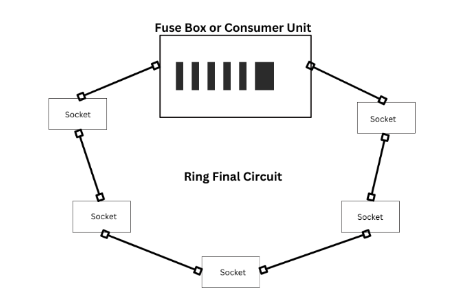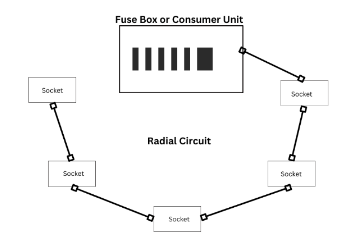
Table of Contents
- What is the difference between a single and double socket?
- Converting a single plug to a double DIY?
- Single Pole Vs Double Pole?
- Unswitched and switched?
- Dangers of Old Plug Sockets
- Do I need an electrician for plug sockets?
- What is a ring circuit?
- What is a radial circuit?
- Where are double sockets best used?
- What are the dangers of a ring final circuit?
- How are sockets tested?
- When should sockets be replaced?
- What DIY electrical work is safe to carry out?
- Summary
July 2024
There are many different designs of SINGLE AND DOUBLE PLUG SOCKETS on the market today but they generally all do the same job despite aesthetic differences between brands and styles.
Most single and double plug sockets can handle the same electrical current flowing through them. It’s a common misconception that a double plug socket can handle twice the power of a single plug socket.
An extension lead can have up to 12 usable ways for plugs to be inserted but it can still only handle 13 amps which is the temporary limit imposed by the fuse installed in the plug top of the extension lead.
Back to top1) What is the difference between a single and double socket?
The difference between a single and a double plug socket is the physical size of each. The standard size of a single plug socket is around 85mm x 85mm and a double 85mm x 146mm. They both can be mounted in a galvanized back box, plasterboard pattress or surface mounting box of 25mm depth.
There is an exception for USB sockets. Some USB sockets will require a slightly deeper box in order to sit safely. Certain products on the market are advertised as requiring a 35mm back box, others say 25mm is acceptable.
In reality, if there are any complications with the wiring behind a USB socket, a 25mm box is likely to be insufficient. This problem will be amplified with a single socket as there is less room in the back box for cables to safely be routed away from fixing screws and the workings of the socket.
Back to top2) Converting a single plug to a double DIY?
Converting a single socket into a double socket is normally a job for a qualified electrician. There are some products on the market that enable a double face plate to be mounted onto a single box. This is a good option if you don’t want the room decoration to be damaged by enlarging an existing socket box hole.
Products such as this allow a double socket to be mounted on to the front of an existing single outlet. This saves mess, is quick and easy to install for an electrician and will only protrude slightly more than an existing socket face from the wall.
Back to top3) Single Pole Vs Double Pole?
What is a single pole socket and a double pole socket? In fact, what is a pole electrically speaking?
The pole is a live conductor generally speaking. Plug sockets that have rocker switches to turn them on and off will isolate one or both live poles when turning the socket off.
A single pole socket will only switch the LINE conductor off when the switch is operated, a double pole socket will switch BOTH the LINE and NEUTRAL conductors off when the switch is operated.
Dual pole sockets and double pole sockets mean the same thing. Double pole sockets are often considered safer than single pole but can cost a little bit more. In real terms the additional cost is fairly minimal.
Back to top4) Unswitched and switched?
A common misconception is that unswitched sockets are old, are illegal or are in some way dangerous. The opposite is true in many situations.
An unswitched socket is incredibly handy actually. Where we have appliances that obstruct their own power supply, it is useful to have an unswitched socket with a switch mounted elsewhere to enable the appliance to be turned off at the wall outlet. Double pole switches are ideal for this purpose.
Think of a television that is mounted in front of its own power supply socket on the wall. It’s incredibly difficult to turn that appliance off without wrangling your hand in behind the ever-slimming television sets, much easier to turn the TV off completely with an unswitched socket and a double pole switch mounted elsewhere.
Washing machines are another great example. When a washing machine goes faulty it can trip the electrical supply to half of or the entire property. Imagine trying to move the appliance out of the way and dealing with waste pipes, water pipes and wires?
It is far easier to disconnect the power supply to the appliance using a separate switch mounted elsewhere. The electrical supply to the property can then be reinstated safely with the appliance isolated.
5) Dangers of Old Plug Sockets
As plug sockets age, they can wear out, internals can become dirty, loose, or corroded. This can lead to issues such as:
Plug sockets are not designed to last forever. Many modern plug sockets come with a 25 year guarantee from certain manufacturers such as British General, Selectric and others.
Back to top6) Do I need an electrician for plug sockets?
Where you wish to replace plug sockets for new ones it is strongly advisable to have an electrician to carry out this work. It is not a simple case of swapping out the sockets for new ones, turning the electrical supply back on and hoping for the best.
The plug socket circuit should be tested prior to the changeover to ensure that there are no breaks, high resistances or poor insulation quality on the cabling. This then sets a benchmark for the swap over of the sockets.
Once the changeover has been complete, the circuit should be tested again to ensure that no damage has occurred and that the circuit has no break and is continuous (electrically speaking).
To carry out this work with no testing (as is the case with DIY electrical work) is potentially dangerous and could result in a fire.
Swapping an old socket for a new socket may appear to be an easy job but in reality, there are many requirements that need to be fulfilled under the wiring regulations to achieve compliance and safety.
7) What is a ring circuit?
A Ring Final Circuit (sometimes referred to as a Ring Main) is a circuit that involves a loop of cable that begins and ends back at the consumer unit / fuse box.
This loop of cable leaves the consumer unit, enters the first socket on the ring then leaves and enters the second socket on the ring. This carries on until the cable leaves the final socket and returns to the consumer unit.
Most socket circuits in an older house will be a ring final circuit. The practice was common in the UK due to copper shortages after the second world war. This is still in practice today especially where kitchen sockets are on their own circuit.
This wiring method is known as a ring final circuit. There are certain requirements that need to be fulfilled under BS7671 wiring regulations when installing, testing, and commissioning ring final circuits.
One of the requirements is the need to achieve continuity on each conductor (wire) on the circuit. The LINE, NEUTRAL and CPC (Circuit Protective Conductor or Earth).
Back to top8) What is a radial circuit?
A Radial circuit is virtually identical to a ring final circuit except when the cable reaches the last socket on the circuit, there is no return cable to the consumer unit.
Radial circuits are becoming more common with newer homes where there is an upstairs sockets circuit, a downstairs sockets circuit and a kitchen sockets circuit. 
There is not the need for the power of a ring final circuit in most homes other than the kitchen.
Kitchen radial circuits are becoming more common but using a thicker cable and larger circuit breaker to cope with the power demands in the kitchen.
Back to top9) Where are double sockets best used?
From experience, double socket outlets are always the best decision for any installation. Single socket outlets inevitably get converted to doubles at some point during their lifetime as there is always a need for an additional wall socket somewhere.
They are easier to wire up in the first place due to the increased space in the box behind the socket front and the initial cutting out of the plasterboard or masonry takes little extra effort.
Back to top10) What are the dangers of a ring final circuit?
The issue with a ring final circuit is generally poor DIY alterations.
There are specific requirements for ring final circuits alterations and additions under the wiring regulations which must be adhered to for safety.
It is possible to overload a ring final circuit unknowingly by adding too many spurs (additional socket added that is NOT part of the ring itself), conductors falling loose out the back of the socket and rings becoming broken over time.
Electrical sockets have many cables, connections, terminal screws, and opportunities for wires to fall out. The danger with a ring circuit is that, you will not know if a cable has fallen out and the ring has become broken.
The circuit will appear, on the surface, to operate as normal but as a break has developed, the circuit can no longer handle the level of electrical current it could when it was complete.
Back to top11) How are sockets tested?
Both SINGLE AND DOUBLE PLUG SOCKETS are tested the same way by an electrician. When carrying out initial testing before commissioning and periodic testing, the single and double plug sockets are checked by the electrician with a low resistance ohmmeter or multi-function tester in much the same way.
A cheap socket tester is not sufficient for the job of electrical testing and should only be used as a general indicator that there is power to the socket and likely correct polarity.
The electrician will double check that the readings are good at the consumer unit once installation of the single outlets and double outlets has been carried out.
Back to top12) When should sockets be replaced?
An electrical outlet has a life span. There is a good chance that if your sockets are over 20 years old that there are loose connections internally, on the rear of the faceplate or signs of damage on the fixing positions or around the electrical outlet pin entries.
It’s a good idea to have older sockets replaced as the live terminal, neutral terminal and earth terminal can suffer from corrosion, rust, debris ingress and general poor resistances with age.
New outlets should be installed by a competent person (qualified electrician) to ensure that the cable cores are not damaged, the connections are sufficiently tight and the installation is tested and certified as safe to re-energise afterwards.
Back to top13) What DIY electrical work is safe to carry out?
- Changing a light bulb
- Installing a new plug top
- Some home electrical safety checks
- Checking and replacing extension leads
14) Summary
There are not many differences between single and double plug sockets but out of preference double sockets should always be installed to maximise convenience and to future proof the wiring installation.
Great care should be taken around electrical systems and works should only be carried out by a professional to ensure that testing, inspection, and installation are all carried out safely.
Back to top











